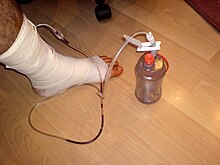Drainage (medicine)
A drainage is a medical treatment. It is used to divert or suck off abnormal or excessive body fluids or gases in order to restore a normal state.
In principle, a distinction is inner from the outer drainage . With the former, obstacles are surgically (often minimally invasive ) bypassed, short circuits ( anastomoses ) are created between hollow organs such as the esophagus, stomach, intestines or pent-up fluids ( cyst contents ) are drained into hollow organs (stomach or intestines). With external drainage, the drainage takes place from the inside of the body to the outside.
designation
The individual forms of internal drainage are occasionally given their own names, but often only after the organs involved (e.g. pseudocystojejunostomy , gastrojejunostomy ).
In the case of external drainage , the naming of the individual forms is very inconsistent and not standardized. The names of the inventors of the respective method ( Bülau drainage , Blake drainage) or the necessary drain aid ( Penrose drain, Redon drain), or the drained body regions (e.g. abdominal drainage, thorax drainage) or underlying disease states are used to give names ( Wound drainage, pneumothorax drainage, bleeding drainage) or the way to generate suction (thorax suction drainage, capillary drainage). The type of access and at the same time the language constructions describing the affected organ are common (e.g. percutaneous transhepatic cholangiodrainage , PTCD for short).
Working principles
Every external and some internal drainage requires one or more rubber straps or a hose made of rubber or plastic, called a drain , or other self-absorbing materials such as gauze or foam.
On the other hand, there needs to be a pressure difference (pressure gradient, suction) between the place of accumulation and the place of collection, which can be generated in four different physical ways:
- Gravity drainage : The secretion regularly collects on the floor of a wound, body or abscess cavity. A tubular drain with one or more openings leads the secretion from the lowest point into a lower-lying collection bag. Examples of this are the Robinson drainage and the chest drainage without suction.
- Capillary drainage : The type uses the adhesion ( capillary force ) to drain the se- or excreta even upwards into a bandage. This principle is implemented with simple gauze as a wick in a wound, with the Penrose-Drain (gauze wick in a thin-walled rubber tube) or with the Easy-Flow-Drain (a soft plastic tube with a narrow inner lumen that is ribbed lengthways or a washboard-like shape). This easy-flow drainage is used for B. after a conventional cholecystectomy (removal of the gallbladder), whereby the drainage is placed in the former gallbladder bed to drain the bleeding and / or bile secretion that occurs. It is assumed, however, that the presence of this drainage provokes the delivery or formation of the liquid in the first place (in the sense of a foreign body reaction ).
- Siphon drainage : Here the principle of communicating tubes is used to initially drain secretions or excretions upwards, but finally into lower-lying collection bags or bottles. It is mainly used to drain gastric / intestinal / biliary secretions. The difference in height between the liquid level in the reservoir and in the collecting vessel is an absolute requirement for proper function. The suction effect is low and corresponds roughly to the difference described (in cm water column).
- Suction drainage : In this form, suction is always generated externally. On the one hand, so-called vacuum bottles (vacuum bottles), such. B. used in Redon drainage or self-expanding bellows or plastic balls ( Jackson-Pratt drainage ), on the other hand, real suction pumps. The suction of the "vacuum bottle" can only be measured and controlled directly with additional aids, but is limited due to the limited bottle volume and decreases with increasing filling. But there are also vacuum bottles that have their own hand pump and manometer. In the thoracic suction drainage (incorrectly called Bülau drainage), the z. B. is used in the case of a pneumothorax after injury or surgery in the chest , a defined suction (usually 15-30 cm water column) is generated either with an electrically operated regulated pump or with another suction pump.
External drainage systems can be open , half-open or closed : while in the first group the liquid is drained into the bandage, in the second group it is drained into an open bottle or an adhesive bag stuck to the skin. Only in the third group is the secretion air-tightly drained through the hose connection into a collection bag or system with or without additional suction. This last group in particular meets all hygienic requirements.
side effect
Bacteria can penetrate the wound area via wound drainage; they are a risk factor for wound infections. The proximity of drainages to vessels or intestines can rarely cause erosion injuries. The longer drains have to stay in the wound, the more the hose ends grow together in the wounds, and removal can be painful.
Goal setting
External drainage can also be divided into two classes according to its purpose:
- Preventive drainage : Here, drains are introduced preventively and temporarily, usually limited to 24 to 48 hours, because e.g. B. fear of bleeding (postoperative Redon or bleeding drainage)
- Curative (healing) drains : They have a therapeutic objective, such as B. a drainage drainage for abscesses.
Study situation
Recent studies speak against the use of wound drainage in aseptic operations.
See also
further reading
- Margret Liehn, Lutz Steinmüller, JR Döhler: Surgical manual: basics, instruments, surgical procedure , Springer, 2011, ISBN 978-3-642-16845-1 , Chapter 1.8 “Drainages”, pp. 24–28
Web links
Individual evidence
- ↑ http://www.urologielehrbuch.de/wunddrainage.html Urology textbook - drainages in urology
- ↑ Wound drainage - if in doubt, please don't! Thieme Verlagsgruppe , 2010, accessed on July 19, 2014 .
